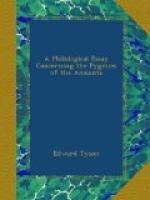Well, if they are so good Sports-men, as to kill Hares and Foxes with Ravens, Kites, Crows and Eagles, I can’t see how I can bring off Homer, for making them fight the Cranes themselves. Why did they not fly their Eagles against them? these would make greater Slaughter and Execution, without hazarding themselves. The only excuse I have is, that Homer’s Pygmies were real Apes like Men; but those of Ctesias were neither Men nor Pygmies; only a Creature begot in his own Brain, and to be found no where else.
Ctesias was Physician to Artaxerxes Mnemon as Diodorus Siculus[A] and Strabo[B] inform us. He was contemporary with Xenophon, a little later than Herodotus; and Helvicus in his Chronology places him three hundred eighty three years before Christ: He is an ancient Author, ’tis true, and it may be upon that score valued by some. We are beholden to him, not only for his Improvements on the Story of the Pygmies, but for his Remarks likewise on several other parts of Natural History; which for the most part are all of the same stamp, very wonderful and incredible; as his Mantichora, his Gryphins, the horrible Indian Worm, a Fountain of Liquid Gold, a Fountain of Honey, a Fountain whose Water will make a Man confess all that ever he did, a Root he calls [Greek: paraebon], that will attract Lambs and Birds, as the Loadstone does filings of Steel; and a great many other Wonders he tells us: all of which are copied from him by AElian, Pliny, Solinus, Mela, Philostratus, and others. And Photius concludes Ctesias’s Account of India with this passage; [Greek: Tauta graphon kai mythologon Ktaesias. legei t’ alaethestata graphein; epagon hos ta men autos idon graphei, ta de par auton mathon ton eidoton. polla de touton kai alla thaumasiotera paralipein, dia to mae doxai tois mae tauta theasamenois apista syngraphein;] i.e. These things (saith he) Ctesias writes and feigns, but he himself says all he has wrote is very true. Adding, that some things which he describes, he had seen himself; and the others he had learn’d from those that had seen them: That




